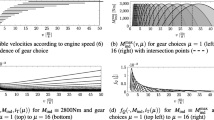Abstract
In the first part of this paper series, a new solver, called HDDP, was presented for solving constrained, nonlinear optimal control problems. In the present paper, the algorithm is extended to include practical safeguards to enhance robustness, and four illustrative examples are used to evaluate the main algorithm and some variants. The experiments involve both academic and applied problems to show that HDDP is capable of solving a wide class of constrained, nonlinear optimization problems. First, the algorithm is verified to converge in a single iteration on a simple multi-phase quadratic problem with trivial dynamics. Successively, more complicated constrained optimal control problems are then solved demonstrating robust solutions to problems with as many as 7 states, 25 phases, 258 stages, 458 constraints, and 924 total control variables. The competitiveness of HDDP, with respect to general-purpose, state-of-the-art NLP solvers, is also demonstrated.
















Similar content being viewed by others
Notes
This option does not exist in the original IPOPT package, which could bias the results, so we modified the source code to be able to specify the step between two successive iterates. In addition, larger steps are allowed when exact second-order derivatives are used, since the estimated optimal step is expected to be more accurate in that case.
If nonlinear stage constraints are present, they are handled with the range-space method described in the previous subsection.
In practice, the thrust magnitudes are set to a very small value so that sensitivities with respect to the angles do not vanish.
The maximum thrust is 0.135 N in the original GTOC4 problem. The authors raise the maximum thrust value because the GTOC4 problem is not feasible with the original maximum thrust value when the analytical Kepler model is used to approximate the low-thrust trajectory.
References
Chinchuluun, A., Pardalos, P.M., Enkhbat, R., Tseveendorj, I.: Optimization and Optimal Control: Theory and Applications. Springer Optimization and Its Applications, vol. 39. Springer, Berlin (2010)
Jacobson, D.H., Mayne, D.Q.: Differential Dynamic Programming. Elsevier, New York (1970)
Whiffen, G.J.: Static/dynamic control for optimizing a useful objective. No. Patent 6496741, December 2002
Colombo, C., Vasile, M., Radice, G.: Optimal low-thrust trajectories to asteroids through an algorithm based on differential dynamic programming. Celest. Mech. Dyn. Astron. 105(1), 75–112 (2009)
Gill, P.E., Murray, W., Saunders, M.A.: SNOPT: an SQP algorithm for large-scale constrained optimization. SIAM J. Optim. 12(4), 979–1006 (2002)
Wachter, A., Biegler, L.T.: On the implementation of a primal–dual interior point filter line search algorithm for large-scale nonlinear programming, mathematical programming. Math. Program. 106(1), 25–57 (2006)
Lantoine, G.: A methodology for robust optimization of low-thrust trajectories in multibody environments. Ph.D. Thesis, School of Aerospace Engineering, Georgia Institute of Technology, Georgia (2010)
Byrd, R.H., Nocedal, J., Waltz, R.A.: KNITRO: an integrated package for nonlinear optimization. In: Large Scale Nonlinear Optimization, pp. 35–59. Springer, Berlin (2006)
Coleman, T.F., Li, Y.: An interior trust region approach for nonlinear minimization subject to bounds. SIAM J. Optim. 6(2), 418–445 (1996)
Fletcher, R., Leyffer, S.: Nonlinear programming without a penalty function. Numerical analysis report na/195, Department of Mathematics, University of Dundee, Scotland (1997)
Jain, S.: Multiresolution strategies for the numerical solution of optimal control problems. Ph.D. Thesis, School of Aerospace Engineering, Georgia Institute of Technology, Atlanta, GA (2008)
Arsenault, J.L., Ford, K.C., Koskela, P.E.: Orbit determination using analytic partial. Derivatives of perturbed motion. AIAA J. 8, 4–12 (1970)
Sims, J.A., Finlayson, P., Rinderle, E., Vavrina, M., Kowalkowski, T.: Implementation of a low-thrust trajectory optimization algorithm for preliminary design. In: AAS/AIAA Astrodynamics Specialist Conference and Exhibit, Keystone, CO, August (2006). No. AIAA-2006-674
Russell, R.P., Ocampo, C.A.: Optimization of a broad class of ephemeris model Earth–Mars cyclers. J. Guid. Control Dyn. 29(2), 354–367 (2006)
Lantoine, G., Russell, R.P.: A fast second-order algorithm for preliminary design of low-thrust trajectories. In: 59th International Astronautical Congress, Glasgow, Scotland, 29 September–3 October (2008). Paper IAC-08-C1.2.5
Powell, M.J.D.: Algorithms for nonlinear constraints that use Lagrangian functions. Math. Program. 14, 224–248 (1978)
Bate, R., Mueller, D., White, J.: Fundamentals of Astrodynamics. Dover, New York (1971)
Pitkin, E.T.: Second transition partial derivatives via universal variables. J. Astronaut. Sci. 13, 204 (1966)
Dargent, T., Martinot, V.: An integrated tool for low thrust optimal control orbit transfers in interplanetary trajectories. In: Proceedings of the 18th International Symposium on Space Flight Dynamics, Munich, Germany, October, p. 143 (2004). German Space Operations Center of DLR and European Space Operations Centre of ESA
Acknowledgements
This work was partially supported by Thales Alenia Space. The authors thank Thierry Dargent for support and collaborations, and Greg Whiffen for his valuable insight, feedback, and general introductions to DDP based methods.
Author information
Authors and Affiliations
Corresponding author
Rights and permissions
About this article
Cite this article
Lantoine, G., Russell, R.P. A Hybrid Differential Dynamic Programming Algorithm for Constrained Optimal Control Problems. Part 2: Application. J Optim Theory Appl 154, 418–442 (2012). https://doi.org/10.1007/s10957-012-0038-1
Received:
Accepted:
Published:
Issue Date:
DOI: https://doi.org/10.1007/s10957-012-0038-1




